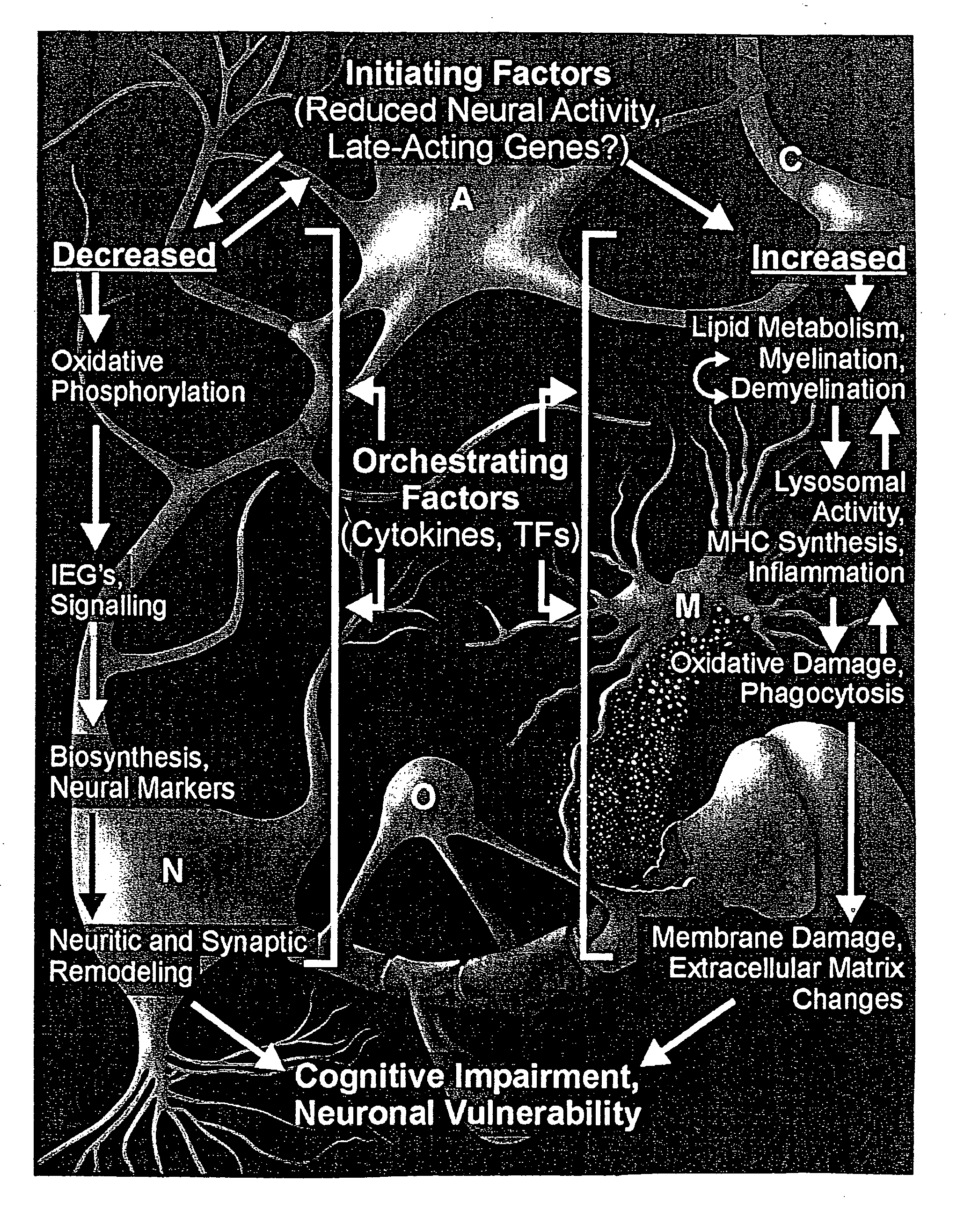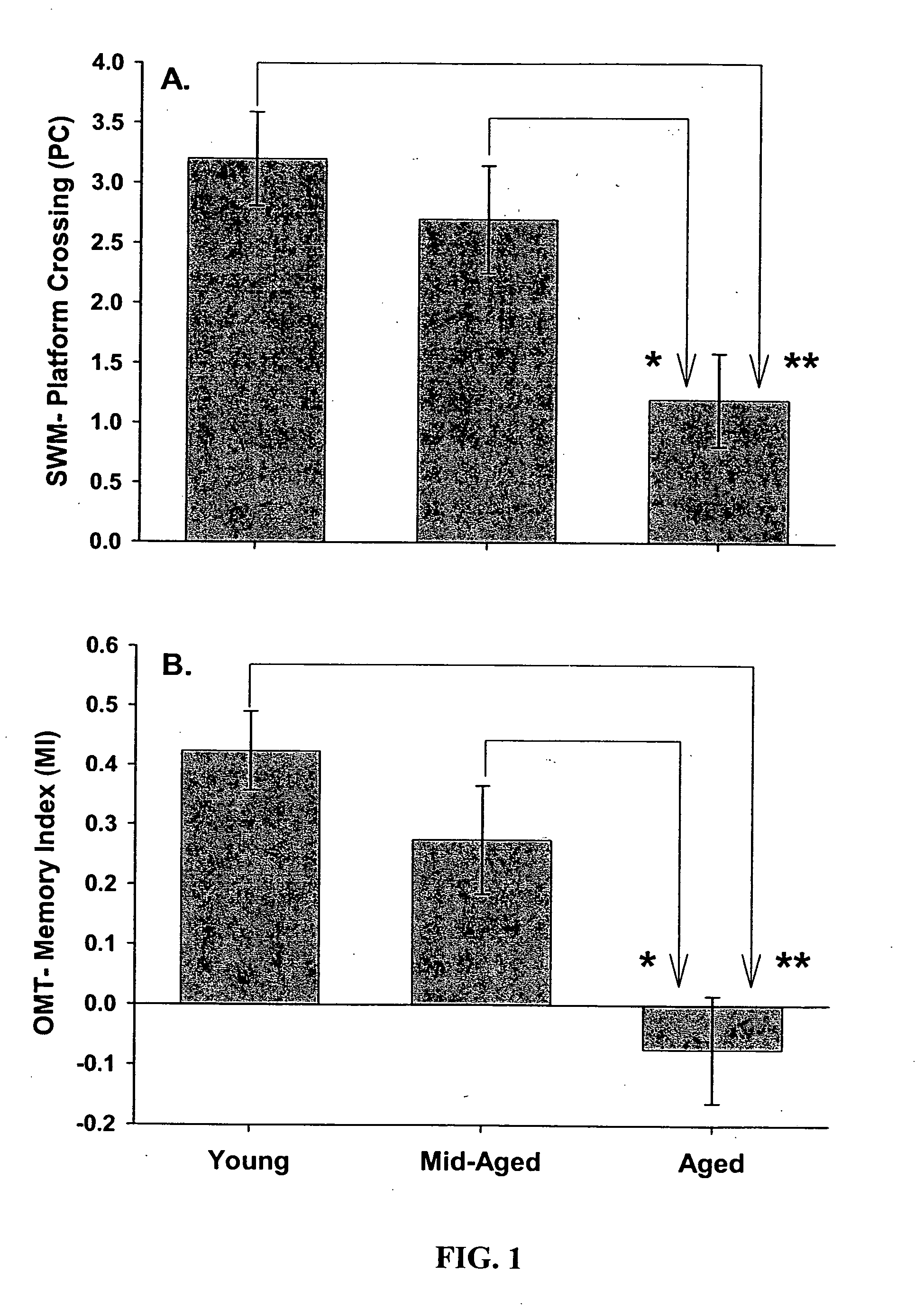Gene expression profile biomarkers and therapeutic targets for brain aging and age-related cognitive impairment
a gene expression profile and brain aging technology, applied in the field of gene expression profile biomarkers and therapeutic targets for brain aging, can solve the problems of limited impact, increased risk of alzheimer's disease, cognitive decline, etc., and achieve the effects of increasing neuronal vulnerability, reducing neuronal activity and/or oxidative metabolism, and increasing lipid metabolism
- Summary
- Abstract
- Description
- Claims
- Application Information
AI Technical Summary
Benefits of technology
Problems solved by technology
Method used
Image
Examples
example 1
Behavioral Results
Thirty animals in three age groups (n=10 / group) were trained sequentially on two tasks, first in the Morris spatial water maze (SWM) and then in the object memory task (OMT). Male Fischer 344 rats aged 4 months (Young, n=10), 13 months (Mid-Aged, n=10) and 24 months (Aged, n=10) were used. Overall, the training / testing lasted seven days, and hippocampal tissue was collected 24 hr later. Training or testing occurred on each day except for the 2nd and 3rd days of the seven-day sequence.
Methods used here for cognition assessment in the Morris Spatial Water Maze (SWM), a task sensitive to both hippocampal function and aging, have been described previously Norris C M & Foster T C, Neurobiol Learn Mem 71, 194-206 (1999). Briefly, rats were trained in a black tank, 1.7 M in diameter, filled with water (27±2° C.). Behavioral data were acquired with a Columbus Instruments tracking system. After habituation to the pool, animals were given cue training with a visible pla...
example 2
Gene Microarray Chip Results
Microarray analyses were performed on hippocampal CA1 tissues from each of the same behaviorally characterized 30 animals (one chip per animal), but one chip was lost for technical reasons, leaving a data set of 29 microarrays (Young=9, Mid-Aged=10, Aged=10). For tissue preparation, twenty-four hours after completion of the OMT testing, animals were anesthetized with CO2 gas and decapitated. The brains were rapidly removed and immersed in ice-cold, oxygenated artificial cerebrospinal fluid consisting of (in mM): 124 NaCl, 2 KCl, 1.25 KH2PO4, 2 MgSO4, 0.5 CaCl2, 26 NaHCO3, and 10 dextrose. Hippocampi were removed and the CA1 region from one hippocampus per animal were dissected by hand under a stereomicroscope. The CA1 tissue block from each animal was placed in a microcentrifuge tube and flash frozen in dry ice for RNA isolation.
For RNA isolation, total RNA was isolated using the TRIzol reagent and following the manufacturer's RNA isolation protocol ...
example 3
Multi-Step Gene Identification Algorithm
The analytic algorithm of the invention, which addresses the bioinformatics issues noted above, comprise three main steps aimed first, at reducing the number of comparisons (to manage type I error), second, at reliably detecting modest aging differences with global statistical analyses (by ANOVA), and third, at identifying aging-related expression changes that were quantitatively correlated with cognitive function (by Pearson's test; Armitage P & Berry G Statistical Methods in Medical Research, 2nd Edn., 200-205 (1987)) (see, FIG. 2).
Multiple Comparison Reduction Step. The expected false positives in a series of multiple comparisons (false positive rate) are predicted to be a percentage of the total statistical comparisons to be made, as defined by the p-value (i.e., tests at p<0.05 will on average generate 5% false positives). Accordingly, the absolute numbers of expected false positives can be decreased simply by reducing the total...
PUM
| Property | Measurement | Unit |
|---|---|---|
| Fraction | aaaaa | aaaaa |
| Electric charge | aaaaa | aaaaa |
| Atomic weight | aaaaa | aaaaa |
Abstract
Description
Claims
Application Information
 Login to View More
Login to View More - R&D
- Intellectual Property
- Life Sciences
- Materials
- Tech Scout
- Unparalleled Data Quality
- Higher Quality Content
- 60% Fewer Hallucinations
Browse by: Latest US Patents, China's latest patents, Technical Efficacy Thesaurus, Application Domain, Technology Topic, Popular Technical Reports.
© 2025 PatSnap. All rights reserved.Legal|Privacy policy|Modern Slavery Act Transparency Statement|Sitemap|About US| Contact US: help@patsnap.com



